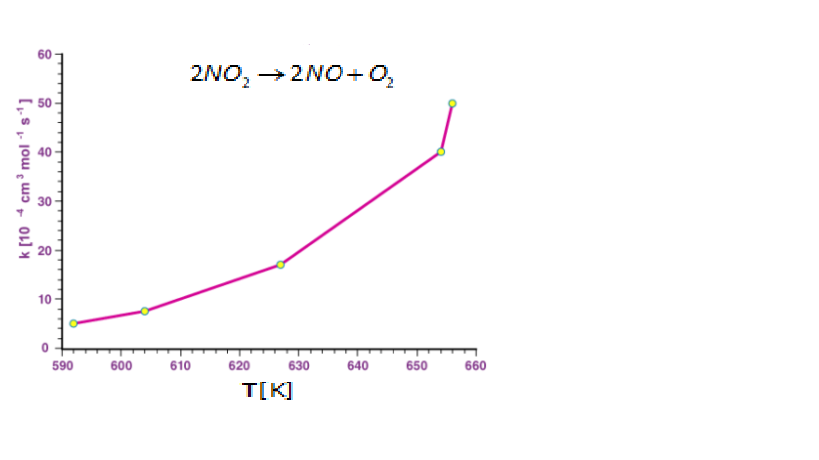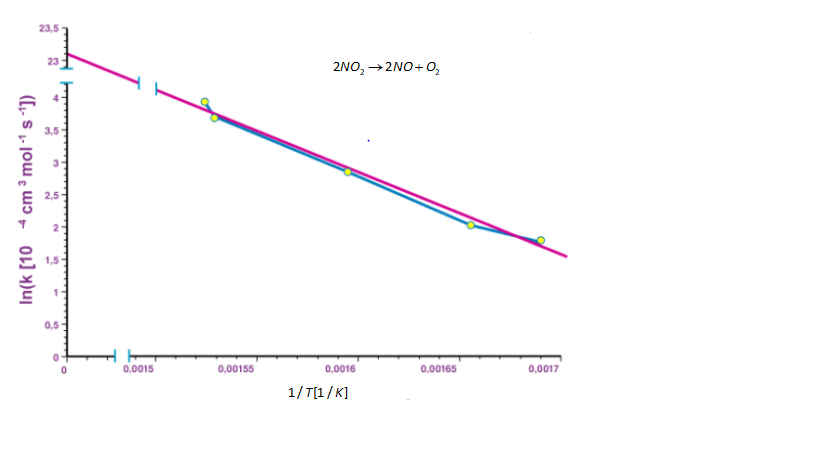
How do you plot Arrhenius equation?
Answer
458.7k+ views
Hint: While plotting a Arrhenius equation, the logarithm is taken on both side of the equation where rate constant (lnk) is plotted on the y-axis and the inverse of absolute temperature $\dfrac{1}{T}$ is plotted on the x-axis.
Complete step by step answer:
The Arrhenius equation is the expression which shows the relation between rate constant, absolute temperature, and A factor.
The expression for Arrhenius equation is shown below.
$k = A{e^{ - Ea/RT}}$
Where,
k is the rate constant of the chemical reaction.
A is the pre-exponential factor.
e is the base of natural logarithm
${E_a}$ is the activation energy
R is the universal gas constant.
T denotes the absolute temperature.
For the reaction
$2N{O_2} \to 2NO + {O_2}$
The graph is plotted where rate constant (k) is given on y-axis and absolute temperature is given on the x-axis.

For the given reaction, when logarithm is taken on both sides of the equation, the Arrhenius equation is given as shown below.
$\ln k - \ln (A{e^{ - Ea/RT}})$
By solving the equation, we get
$\ln k = \ln (A) + \ln ({e^{ - Ea/RT}})$
$\ln k = \ln (A) + ( - {E_a}/RT) = \ln (A) - ({E_a}/R)(1/T)$
As, the lnA is constant, the equation corresponds to the straight line (y = mx + c) where slope m is $\dfrac{{{E_a}}}{R}$ When the logarithm of rate constant (lnk) is plotted on the y-axis and the inverse of absolute temperature $\dfrac{1}{T}$ is plotted on the x-axis. The resulting graph obtained is known as Arrhenius plot.
The graph is shown below.

Note:
The rate of reaction is dependent on the temperature. As the temperature increases, the rate of reaction also increases and as the temperature decreases the rate of reaction also decreases. The pre-exponential factor A is represented by $A = \rho Z$ where $\rho$ is the steric factor and Z is the frequency factor.
Complete step by step answer:
The Arrhenius equation is the expression which shows the relation between rate constant, absolute temperature, and A factor.
The expression for Arrhenius equation is shown below.
$k = A{e^{ - Ea/RT}}$
Where,
k is the rate constant of the chemical reaction.
A is the pre-exponential factor.
e is the base of natural logarithm
${E_a}$ is the activation energy
R is the universal gas constant.
T denotes the absolute temperature.
For the reaction
$2N{O_2} \to 2NO + {O_2}$
The graph is plotted where rate constant (k) is given on y-axis and absolute temperature is given on the x-axis.

For the given reaction, when logarithm is taken on both sides of the equation, the Arrhenius equation is given as shown below.
$\ln k - \ln (A{e^{ - Ea/RT}})$
By solving the equation, we get
$\ln k = \ln (A) + \ln ({e^{ - Ea/RT}})$
$\ln k = \ln (A) + ( - {E_a}/RT) = \ln (A) - ({E_a}/R)(1/T)$
As, the lnA is constant, the equation corresponds to the straight line (y = mx + c) where slope m is $\dfrac{{{E_a}}}{R}$ When the logarithm of rate constant (lnk) is plotted on the y-axis and the inverse of absolute temperature $\dfrac{1}{T}$ is plotted on the x-axis. The resulting graph obtained is known as Arrhenius plot.
The graph is shown below.

Note:
The rate of reaction is dependent on the temperature. As the temperature increases, the rate of reaction also increases and as the temperature decreases the rate of reaction also decreases. The pre-exponential factor A is represented by $A = \rho Z$ where $\rho$ is the steric factor and Z is the frequency factor.
Recently Updated Pages
Master Class 12 Economics: Engaging Questions & Answers for Success

Master Class 12 Maths: Engaging Questions & Answers for Success

Master Class 12 Biology: Engaging Questions & Answers for Success

Master Class 12 Physics: Engaging Questions & Answers for Success

Master Class 12 Business Studies: Engaging Questions & Answers for Success

Master Class 12 English: Engaging Questions & Answers for Success

Trending doubts
Draw a labelled sketch of the human eye class 12 physics CBSE

Differentiate between homogeneous and heterogeneous class 12 chemistry CBSE

What are the major means of transport Explain each class 12 social science CBSE

Which of the following properties of a proton can change class 12 physics CBSE

What is a transformer Explain the principle construction class 12 physics CBSE

Why is the cell called the structural and functional class 12 biology CBSE




